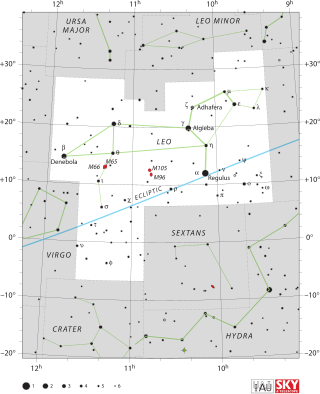Top Qs
Timeline
Chat
Perspective
HD 96063
Red giant From Wikipedia, the free encyclopedia
Remove ads
HD 96063 (proper name Dingolay) is a 8th-magnitude red-giant branch star located about 454 light-years (139 pc) away in the constellation of Leo. It is orbited by one confirmed exoplanet, HD 96063 b (proper name Ramajay), a gas giant slightly larger and more massive than Jupiter.[7]
Remove ads
Nomenclature
In 2019, the Republic of Trinidad and Tobago was assigned to giving the HD 96063 system a proper name as part of the IAU100 NameExoWorlds Project, planned to celebrate the hundredth anniversary of the International Astronomical Union (IAU), which grants the right to name an exoplanetary system to every state and territory in the world.[8] Names were submitted and selected within Trinidad and Tobago, which were then presented to the IAU to be officially recognized.[9] On 17 December 2019, the IAU announced that HD 96063 and its planet, b, were named Dingolay and Ramajay, respectively.[10]
The two names are both derived from terms related to the Trinidad and Tobago Carnival. Dingolay is a dance form that represents the culture and language of Trinidad and Tobago's ancestors via intricate movements. Ramajay is a steelpan style of singing and music that celebrates Trinidad and Tobago's forefathers' culture and language.[10]
Remove ads
Stellar characteristics
HD 96063 is an evolved yellow/orange star with an effective temperature of about 5,000 K,[4] typical of stars entering the red-giant branch. Its precise nature, however, has been controversial. Once classified as a G6-type main-sequence star,[11] the star is more recently thought to be a K-type "yellow giant,"[12][13] somewhere between three and five times as large as the Sun.[5][4] When the planet HD 96063 b was discovered, the star was assumed to be 9.0±3.0 billion years old with a sun-like mass (1.020±0.072 M☉),[7] but subsequent studies consider it to be more massive at about 1.4 M☉, and thus younger (2.92±0.81 Gyr).[5] With a luminosity roughly ten times that of the Sun and a distance of 454 light-years, the star has an apparent magnitude of 8.254, too faint to be seen from Earth by the naked eye.[6][1]
Remove ads
Planetary system
In 2011, radial-velocity observations made at the W. M. Keck Observatory revealed the existence of an exoplanet around HD 96063.[7] The planet, HD 96063 b, is thought to be a gas giant at least 1.265 times the mass of Jupiter, which orbits its host star at a distance of 1.11 AU with an Earth-like period of 362 days. Its orbit is moderately eccentric, with an eccentricity comparable to that of planet Mercury (0.2056).[4][14]
See also
References
External links
Wikiwand - on
Seamless Wikipedia browsing. On steroids.
Remove ads

